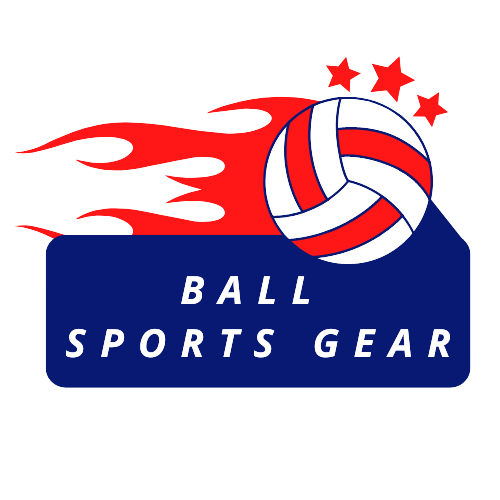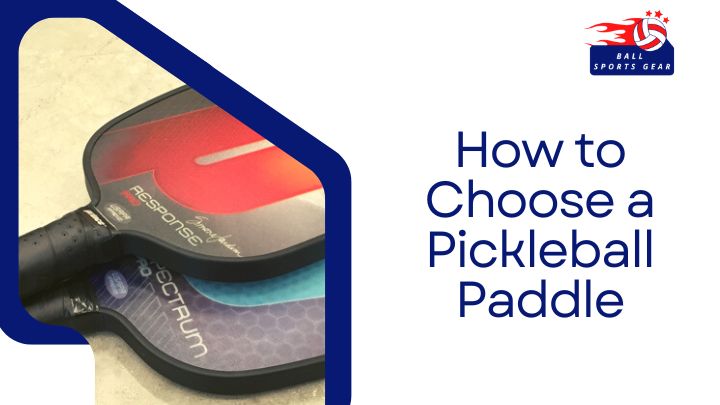There is so much to consider when choosing a pickle ball paddle. There are a lot of features to choose from, so knowing what to look for can be challenging. Luckily, we have researched for you and we write “How to Choose a Pickleball Paddle?” just for you.
In the case of a pickleball paddle, regardless of whether it is your first one or your next one, there are important considerations to make before buying. Ensuring you have the right paddle makes a huge difference in your game. This article will discuss the different features you should consider when choosing the right pickleball paddle. Invest in a good pickleball paddle to take your game to the next level. Let’s find out how to choose a pickleball paddle.
Pickleball Paddle Guide for Players
In pickleball, paddles are the most essential item. Choosing the right paddle for oneself is also important. The following is a short pickleball guide for beginners and intermediate players.
Pickleball Paddles for Beginner Players
Your first pickle ball paddle might be made of composite materials. Still, as your passion for pickleball gets ignited, you’re apt to quickly progress to the intermediate level and want to upgrade to stronger paddles.
To review for beginners, a composite material with a broader hitting surface and a thicker handle, in the beginning, will help with the wear and tear on your arm that may not be in pickleball shape right away.
Pickleball Paddles for Intermediate Players
By now, you’ve likely graduated from the fun and social part of pickleball that will always stay, but the athlete in you has begun to enjoy the competition, and you want equipment to mirror your improvement. It’s time to stack the thick handle, graduate from a wide-hitting surface to a longer one, and ensure your paddle is yellow. As for the handle, a small one can change drastically from your thick one, so you can tape it for purchase and sizing until you become comfortable.
How Do I Choose the Right Pickleball Paddle?
Choosing a pickleball paddle (to clarify, paddles are not racquets) can be overwhelming, especially since hundreds of pickleball paddles are available. Choosing the right types of pickleball paddle can be challenging, regardless of whether you’re a beginner or a pro player. The following are a few things you should keep in mind:
- Core
- Weight
- Shape
- Size
- Material
- Handle
Below are some more details you should know before buying. And you must know where to buy pickleball paddles. So you can get a good brand of pickle ball paddle set.
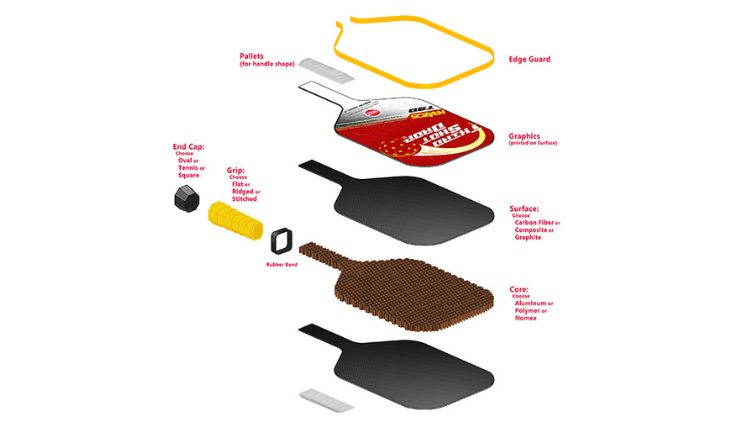
Core
The paddle core affects the feel and energy transfer into the pickleball. Generally in a honeycomb shape, the most common core type is polymer, while the other guts we will cover consist of Nomex and aluminum.
Polymer Core
This is the most common core. It provides a plusher feel than nomex cores and is versatile for driving power and touch shots. Polymer cores offer all-around playability and are quieter than aluminum and nomex cores. If you don’t know which to choose, we recommend picking a paddle with a polymer core for its versatility.
Nomex Core
This is a firmer core that provides the most power and ball speed. While great for energy, nomex cores sacrifice control and lack a plush feel. They are audibly louder than polymer cores for players in a noise ordinance area. These cores are effective for professional singles players or beginners looking for massive, effortless power.
Aluminum Core
Aluminum cores are lightweight and easy to swing but have deficient power levels. These cores are not as loud as nomex but still much more audible than polymer. The light characteristics make this paddle easy to use for juniors or players that have difficulty swinging a standard paddle; however, with the number of lightweight paddles with polymer cores now on the market, aluminum cores are becoming less common and are primarily geared toward the specialized player wanting the absolute highest maneuverability, touch, and control.
Weight
Weight is one of the most important things to consider when selecting a pickleball paddle. The importance of the paddle impacts the ability to play the game.
Weight guidelines for paddles are as follows:
- Light paddles (<7.2 oz)
- Mid-weight paddles(7.3-8.4 oz)
- Heavy paddles (>8.5 oz)
Lightweight pickleball paddles
Our buying guide for beginners explains that new players should select a lighter paddle with better accuracy and wrist action. When you use a paddle that is too heavy, you will quickly get tired.
Known for their control, lightweight paddles are perfect for touch players who prefer drop shots over hard shots. Moreover, they give you a faster response time when you are at the net, and the ball comes flying at you. However, lighter paddles provide less power.
You can use lightweight paddles if you have played ping pong, racquetball, or tennis before and are switching to pickleball.
Mid-weight pickleball paddles
The medium-weight paddle is a good choice if you need help determining what weight is right for you, and players at all levels can use it.
Mid-weight paddles are a good combination of power and control. If players want a game with finesse and power, they should choose paddles that are neither too heavy nor too light. Even though they lack the same power or control as heavy or light paddles, they can still be used in many situations.
Heavyweight pickleball paddles
Power players tend to use heavier paddles as they can kick the ball harder.
You can do it faster when you swing a heavier paddle, but it will take more effort to achieve that speed. A loss of control also accompanies the power.
Heavy paddles are more common in singles as power beats finesse, like in singles tennis. Dinks and drop shots are less prevalent in dollars pickleball than in doubles.
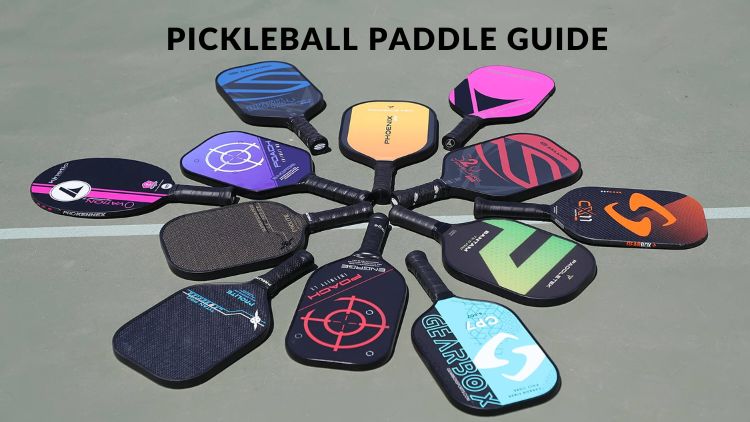
Paddle Shape
The shape of the paddle will affect the size of the sweet spot, power, and maneuverability. According to the rules, the combined length and width, including any edge guard and butt cap, cannot exceed 24 inches, and the paddle length cannot exceed 17 inches. So when we look at paddle shapes, those are the parameters that the brands have to work with.
1. Elongated Shapes
This shape is longer and is usually about 16.5 inches long and 7.5 inches wide. An elongated shape will give you more reach, power, and spin but has a smaller sweet spot and less maneuverability than other forms.
2. Widebody Shapes
These are paddles with a broader face, around 8.5 inches, and a shorter length of about 15.5 inches. This design offers the most significant sweet spot and high maneuverability but at the sacrifice of reach and power.
3. Classic Shapes
This shape was the original paddle shape and is usually about 16 inches long and 8 inches wide. This shape sits between an elongated and widebody shape and, as you can guess, offers a balanced mix of power, spin, forgiveness, and maneuverability.
Grip Size
Once you have decided on the correct paddle weight, the next decision is the grip size. It is essential to pick a pickleball paddle with the correct grip circumference to match your hand size. It sounds simple, but you must choose a grip that fits your hand!
Playing with a pickleball paddle with the wrong grip size for your hand is like running in shoes that don’t fit. A smaller grip allows for more wrist action, making it easier to spin the ball and improving control. Increased wrist movement can also add extra power to your serve.
A larger grip will help increase stroke stability while easing the strain on the wrist, elbow, and shoulder joints. The caveat is that using a paddle handle too large for your hand can lead to an elbow strain. This can lead to tennis elbow and joint pain, especially after playing for an extended time. A crucial part of paddle selection is determining the correct grip size, so please ensure you measure your grip and choose your pickleball paddle accordingly.
Suppose you’ve played or watched tennis or other racket sports. In that case, you are most likely familiar with wrapping the grip with an “overgrip” or tape to customize the circumference to better match your hand size and personal preference.
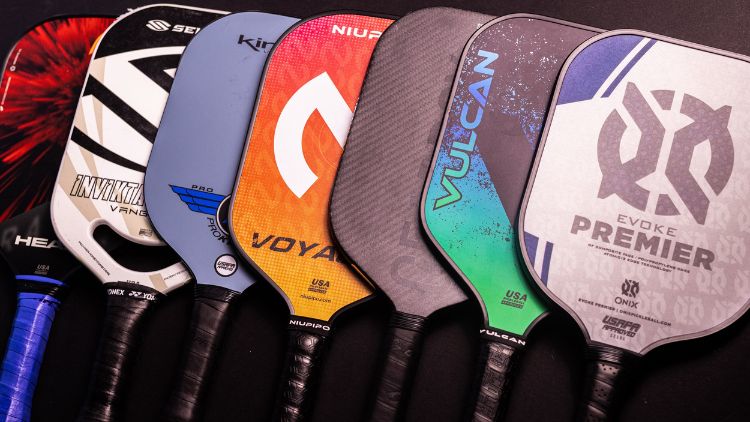
If you buy a high-end paddle, they will usually come with a premium grip (from makers such as Gamma or Pro-lite) which adds a level of comfort and also absorbs sweat. However, if your paddle comes with an inferior grip (or it is worn after you have used it for some time), consider replacing the stock grip with a new premium grip.
Paddle Material
In addition to the material, the size of a pickleball paddle is also essential when choosing one. Among the most commonly used pickleball, paddle materials are:
- Wood- The cheapest pickleball paddles are usually wood and are also the most durable. Wood pickleball paddles, however, are very heavy and need more miniature technology to elevate a pickleball player’s game on the court. If you play pickleball more than a couple of times a year, consider avoiding wooden paddles.
- Graphite – Graphite pickleball paddles are generally more expensive and generate a lot of power because they are very stiff and light.
- Composite – Composite paddles are in the middle of wood and graphite pickleball paddles. It is often favored because composite pickleball paddles come in a wide range of shapes, sizes, weights, and prices, and they can add texture to the surface of the pickleball paddle.
Handle
The length of the handle can vary between 4.5 to 6 inches. Because the total length plus the paddle’s width cannot exceed 24 inches, every inch you add to the handle length removes some surface area of the paddle face.
Here’s a video showing my experiment with various paddle shapes and handle lengths. The results were interesting. You can watch the video if you’d like, but I essentially discovered three things:
- The longer the handle, the more power, and spin you can generate
- Longer paddles equal more power and spin.
- Lower-level players generate more power on average with shorter, wider paddles because they need to be more consistent at hitting the center of the paddle.
Other Considerations for Pickleball Paddles
When choosing a pickleball paddle, also consider the following:
- USA Pickleball Approved – Pickleball paddles that USA Pickleball approves are created or manufactured by the rules of pickleball. This means that you will comply with the laws of pickleball and can use the pickleball paddle when playing in a pickleball tournament. Whether USA Pickleball approves a pickleball paddle will be an essential deciding factor if you consider competitive pickleball and a pickleball tournament. Plus, it is necessary to abide further by the rules of pickleball, so avoid illegal pickleball paddles. For more on the laws of pickleball that pertain to pickleball paddles, check out Pickler’s pickleball blog “Pickleball Rules – Learn How to Start – 5 Things You Need to Play.”
- Thickness – There is no pickleball rule regulating a pickleball paddle’s thickness. As a result, a pickleball paddle may be as thick or as thin as a player desires. With that said, wider pickleball paddles may offer more control and a more prominent sweet spot, which may be necessary (and more forgiving) for beginner pickleball players.
- Edge Guard – Most pickleball paddles have edge guards. However, some pickleball paddles do not have edge guards. An edge guard is essential in protecting your pickleball paddle from damage (often when striking the ground). An edge guard will be necessary for beginner pickleball players.
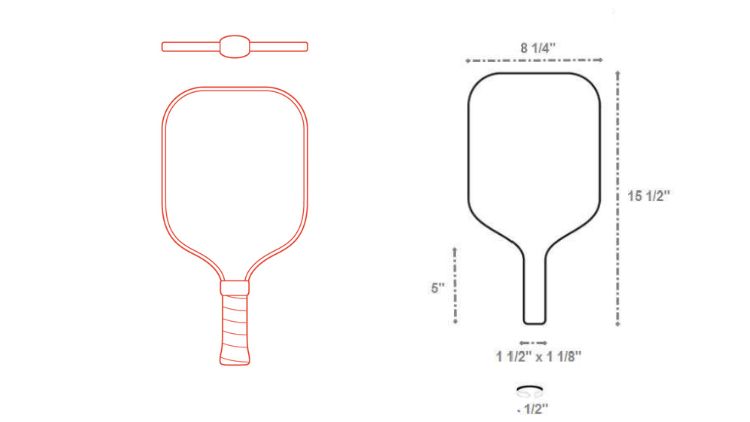
How To Determine Pickleball Paddle Hand Size?
In addition to the pickleball paddle’s size and length, it must be the right size and length for your hand. It would help if you chose a paddle that fits your hand so that you can handle it easily. You’ll learn a lot from it. We have provided some basic guidelines below:
1. Height test
It is intended to work for men and women alike. It works for the people we have tested and is simple to use. If in doubt, pick a smaller grip.
Player Height & Grip Size
- Under 5’2″- 4-inch grip
- 5’3″ to 5’8″- 4 1/4 inch grip
- 5’9″ & taller- 4 1/2 inch grip
2. Finger test
It would help if you held your dominant hand high. On your palm, you will find three significant creases. Measure from the middle crease of the palm to the tip of your ring finger with a ruler. The measurement should reflect the ideal grip size for you. If you need clarification on two sizes, choose the smaller size.
3. Printable grip-sizer chart
Here’s an easy print-out chart we designed to simplify determining your grip size. Please print it out and decide on your approximate grip size.
FAQs
Typically, the cheapest paddles are wooden, and the most expensive is graphite. The effect and experience of overall performance are affected. If your budget allows for it, try to purchase something other than a wooden pickleball paddle, as they are clumsy and offer less benefit than the graphite and composite types of pickleball paddles.
The price is majorly dependent on the material used to make the paddle. Wooden pickleball paddles cost between $15 and $35. To get composite pickleball paddles, you will spend between $40 and $100. Graphite pickleball paddles cost between $90 and $200.
Pickleball paddles with more reach are elongated. Paddles with a longer length allow ideal space when playing shots. Many singles players prefer extended paddles because they can cover more of the court.
Generally, the life span is 1 to 5 years. It also depends on how often and how aggressively you play. Recreational players will get the most longevity out of their paddle.
Conclusion
When hunting for a new pickleball paddle, look at core material and thickness, facing, shape, weight, and handle length to determine what paddle will complement your game.
Learning about the materials and designs of paddles described in this article enables you to see past the marketing jargon and find the right paddle. It always helps to watch and read reviews about the paddle you’re interested in.
